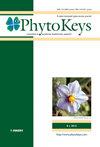Sinosasadamingshanensis (Poaceae, Bambusoideae),形态和分子证据支持的新组合。
IF 1.5
3区 生物学
Q3 PLANT SCIENCES
引用次数: 0
摘要
形态特征和系统发育分析表明,Chimonobambusadamingshanensis应该是Sinosasa属的成员,而不是Chimonobambusa,是与Sinosasahuapingensis和s.mingyuesshanensis相近的一个独特种。在形态上,它不同于所有其他已知的Sinosasa种,节间最初具白色短柔毛,秆叶无耳和三角形小孔鞘叶片,特征是不寻常的在这个属。这一形态上的差异证明了大明山赤藓是一种新组合。本文章由计算机程序翻译,如有差异,请以英文原文为准。
Sinosasadamingshanensis (Poaceae, Bambusoideae), a new combination supported by morphological and molecular evidence.
Morphological characteristics and phylogenetic analyses clearly revealed that Chimonobambusadamingshanensis should be a member of the genus Sinosasa, rather than Chimonobambusa, and is a distinct species close to Sinosasahuapingensis and S.mingyueshanensis. Morphologically, it differs from all the other known Sinosasa species by internodes initially with white pubescent, culm leaf auricles absent and triangularly subulate sheath blades, characteristics that are unusual in this genus. And this morphological distinction warrants recognition of Ch.damingshanensis as a new combination of Sinosasa.
求助全文
通过发布文献求助,成功后即可免费获取论文全文。
去求助
来源期刊

PhytoKeys
PLANT SCIENCES-
CiteScore
2.60
自引率
14.30%
发文量
189
审稿时长
6 weeks
期刊介绍:
PhytoKeys is a peer-reviewed, open-access, online and print, rapidly produced journal launched to support free exchange of ideas and information in systematic botany.
All papers published in PhytoKeys can be freely copied, downloaded, printed and distributed at no charge for the reader. Authors are thus encouraged to post the pdf files of published papers on their homepages or elsewhere to expedite distribution. There is no charge for color.
 求助内容:
求助内容: 应助结果提醒方式:
应助结果提醒方式:


